
Dahomey, a documentary by the French-Senegalese filmmaker Mati Diop, opens with night-time shots of the Seine. The camera hovers over a makeshift souvenir stall—plastic Eiffel towers lit with flashing LEDs—before moving on to a somewhat shabby dinner cruise where a group of crumpled office workers chew slowly. This is neither the perennially elegant nor fashionably transgressive Paris that we expect from the cinema. Rather we see a tired European city in decline.
Having established that this is the place (not) to be, the footage cuts to the Musée du Quai Branly-Jacques Chirac, an institution famed for housing indigenous art from Africa, Asia, and Oceania. Predictably, much of the collection was acquired through colonial conquest, and the museum recently agreed to return 26 royal treasures taken from what was once the Kingdom of Dahomey to what is now the Republic of Benin. We watch as a group of white gallery techs pack up statues of King Glélé and King Béhanzin, the latter of whom led the Dahomey Wars against the French, into crates. Yet once these arrive in Africa, the tone of the film shifts dramatically. Suddenly, the landscape is bright and bustling. Lovely flowers bloom amidst balmy skies. A group of black gallery techs carefully unpack the statues, ready to be displayed in Abomey’s new museum. Then the exhibition opens. Some women dance in beautiful patterned fabrics. Others weep with joy.
This constitutes the first 45 minutes: fading Europe, blossoming Africa, longshots shot by a static camera and very little dialogue bar occasional comments on the condition of the returned artefacts, and the ‘voice’ of a statue-king, describing how it feels to return to a country one no longer recognises or speaks the language of. In other contexts, such a device would be hackneyed—a trite and childish metaphor as to how history might be brought to life—but those other contexts would be Western-European ones. Both the royal treasures and the conversations that they now provoke refer to Vodun, a traditional West African religion that emphasises ancestor worship, believes that the dead cohabit with the living, and that a statue may contain a spirit.
The rest of the film continues to expand on the numerous ways the past haunts the present, as well as to ask, via a university debate, whether the repatriation of these objects is really such a source of simple unencumbered joy. In direct contrast to the proceeding section, the second half is shot mostly in close-up, allowing us to bear witness to a range of very human emotions. A large proportion of local students describe being moved by seeing the works in situ, yet almost all regard their return as a “savage insult” too, it now being revealed that there are near-to 7000 other objects stolen from the Benin people still in France. Among the further questions that this prompts are: What are Macron’s political motivations? Why should we embrace European museum culture? And shouldn’t we decry the insidious manner in which colonialist legacies still dictate our education?

Watching this discussion unfold as part of the Berlinale at Haus der Welt der Kulturen is a strange experience. The 2024 Berlinale has been a constant cause of outrage, first for inviting and then uninviting Germany’s own alt-right party, Alternative für Deutschland; then for the filmmakers who pulled out as part of STRIKE Germany (a movement that boycotts German cultural institutions for silencing Palestinian voices); and then for the filmmakers who decided to participate, but signed an open letter expressing their horror as to how the German arts establishment had compounded the trauma of October 7th by their subsequent weaponization of them.
The choice of venue added a further level of discomfort. Last year HKW reopened after a major restructuring intended to prioritise German migrant voices and post-colonial scholarship. In an environment where even the presence of Palestinian artists is now deemed antisemitic, and Jewish-Israelis are fired from museums for using the word “apartheid” it is hardly surprising that an organisation dependent on government funding such as HKW would remain silent on a subject as contentious as Palestine. The commitment to the work of Franz Fanon referred to on their website rings a little hollow in this context.
Diop is a thoughtful filmmaker, who purposefully asks more questions than she answers. As the screening drew to an end, and the rapturous applause began, I wondered if one of them might be how the predominantly white German crowd that now surrounded me was able to condemn the colonialist regimes that suppressed Vodun, rejoice in the voice of King Béhanzin, and simultaneously view their present-day silencing of Jews and Palestinians as acceptable. Likewise, how they were able to appreciate the Benin students’ anger at France, but not Namibia’s at Germany – the country where Germany committed the first genocide of the 20th century, but which they have yet to pay reparations to. Dahomey is nuanced, unique, and beautiful. Unfortunately, its host’s white, distinctly euro-centric views are not.





